You have the chance to help shape the future by sharing your thoughts on $15 billion in key transportation projects planned for the region over the next 25 years.
Over 200 projects are part of two transportation plans that will be open for public comment from May 9 through June 18 - the Maximize2045 Long Range Transportation Plan and the Transportation Improvement Program (TIP). The Baltimore Regional Transportation Board (BRTB) will vote on these plans on July 23, 2019.
Let us know what you think about our plans to invest in the future of transportation at one of our public meetings.
Join Us for a Meeting in Your Community
Monday, May 20 from 6 to 8:30 p.m.
Harford County Govt Ctr, Room 157
220 S Main St, Bel Air, MD 21014
Tuesday, May 21 from 5 to 7:30 p.m.
Enoch Pratt Free Library, Pennsylvania Ave Branch*
1531 W North Ave, Baltimore, MD 21217
Thursday, May 30 from 5 to 7:30 p.m.
Kent Island Senior Center
891 Love Point Rd, Stevensville, MD 21666
Tuesday, June 4 from 6 to 8:30 p.m.
Arundel Mills Mall, Harmons Community Room
7000 Arundel Mills Circle, Hanover, MD 21076
Wednesday, June 5 from 6 to 8:30 p.m.
CCBC Essex. Administrative Building
7201 Rossville Blvd, Baltimore, MD 21237
Thursday, June 6 from 6 to 8:30 p.m.
Carroll County Govt Ctr, Reagan Room #3
225 N. Center St, Westminster, MD 21157
Monday, June 10 from noon to 1p.m.
Online Meeting- REGISTER at https://bit.ly/2IVCzpG
Tuesday, June 11 from 5 to 7:30 p.m.
Elkridge Public Library, Belmont/Hockley Room
6540 Washington Blvd, Elkridge, MD 21075
Learn more at maximize2045.com or download a meeting flyer (English) or Spanish (en Español).
On behalf of the Baltimore Regional Transportation Board (BRTB), thank you for your interest in our activities and efforts to update the region's long-range transportation plan - Maximize2045: A Performance-Based Transportation Plan. For many, the importance of the long-range transportation plan is the identification of major projects the region expects to implement over the next 20-25 years.
In late spring, the BRTB will release a draft Maximize2045, along with the 2020-2023 Transportation Improvement Program (TIP) and related air quality analysis, for public review. We share with you our steps along the way and invite you to get involved in the process by learning more about the steps and staying tuned for upcoming events and the public comment period.
How Projects are Evaluated
The BRTB approved a process for evaluating and scoring individual candidate projects for Maximize2045. This process is a tool the BRTB uses to compile a set of projects that will benefit the region based on its adopted goals and policies.
Aside from project scores and the need to maintain fiscal constraint, the BRTB considers other factors in establishing the list of projects for Maximize2045. These factors might include such considerations as how ready a project is to move forward in the project development process or how a project might address issues of particular local concern in a specific jurisdiction
A project’s total score consists of two parts:
- a policy score that is a combination of (a) how much of a priority (high, medium, or low) a project is to the submitting jurisdiction or agency and (b) whether or not the project has received financial support from MDOT
- a technical score based on criteria derived directly from the region’s adopted goals and policies.
The technical scoring criteria cover the following areas:
- Roadway safety (does a project include features to reduce injuries and fatalities?)
- Roadway accessibility (does a project incorporate Complete Streets features? does a project support access to an activity hub?)
- Transit accessibility (does a project improve an existing transit station/stop or provide a new transit station/stop?)
- Roadway mobility (will a project improve short- and long-term level of service?)
- Transit mobility (does a project provide additional transit options focused on moving riders reliably and efficiently? is a project expected to increase the average number of daily transit riders?)
- Environmental conservation (will a project avoid effects to ecologically significant lands or historic properties? does a project include features that reduce greenhouse gas emissions?)
- Security (does a project fall on an existing evacuation route or improve a critical link to an existing evacuation route?)
- Investment in priority areas (does a project lie within or connect to a Priority Funding Area or a designated Sustainable Community?)
This evaluation and scoring process supports the BRTB’s federally mandated responsibility to develop and carry out a continuing, cooperative, and comprehensive transportation planning process for the metropolitan area.
Submitted Projects
BRTB members have submitted a list of projects they’d like to have included in Maximize2045. Here are a few highlights:
- Freight related: Construct a full interchange at I-695 and Broening Highway
- Bridge Preservation: Replace the Howard Street Bridge over I-83, rail lines, Falls Road, and the Jones Falls
- Transit related: Add Bus Rapid Transit along U.S. 29 from Ellicott City / Downtown Columbia Transit Center to MD 198
Check out the full list of projects being evaluated
What's Next?
The next steps of the process to develop Maximize2045are:
- Project Evaluation Results – Project Evaluation Results - BMC staff have evaluated the submitted projects and completed the technical review. Based on the combined policy and technical scores, the BRTB selected the best scoring projects that could be implemented over the next 20-25 years given the amount of money available. Using modeling and analytical tools, BMC staff are now determining the potential effects of these projects on the region’s transportation network. These tools include (a) travel demand modeling, (b) air quality conformity modeling (in coordination with the Maryland Department of the Environment), (c) analyses to determine how the projects might benefit or burden Environmental Justice populations, and (d) consultations with resource agencies to identify issues related to potential effects on natural and cultural resources.
- Draft Plan Released for Public Comments – A draft of the plan will be made public for a comment period during May and June 2019 and we’ll hold a public meeting in each jurisdiction in the Baltimore region.
- Respond to comments and vote on a final plan – The BRTB will then review and respond to public comments and vote on a final plan in July 2019.
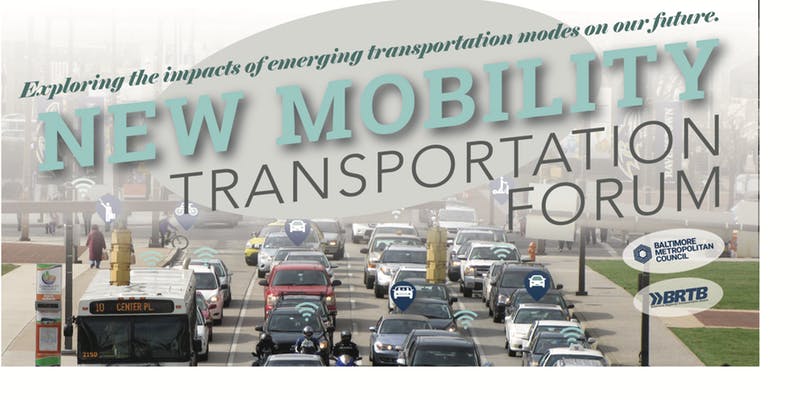
On behalf of the Baltimore Regional Transportation Board (BRTB), the Baltimore Metropolitan Council invites you to the New Mobility Transportation Forum.
Innovative services that capitalize on mobile communications, cash payments, artificial intelligence, and big data — such as applications for ride-hailing; car, scooter, and bikeshare; and trip planning — are changing how we travel. Come hear and ask questions of National and local experts on the forces of change and recent technological and social trends that are impacting the way people and goods move and are propelling changes to public policy, regulations and site and curb design. Intended to bring together transit, auto, shared mobility, freight, and IT leaders to discuss opportunities and challenges and share state-of-the-art strategies that might help the Baltimore Region's transportation network better serve the Region.
- Continental breakfast provided 8:30 AM to 9:00 AM.
- Certified planners may earn certification maintenance credits (pending).
Agenda
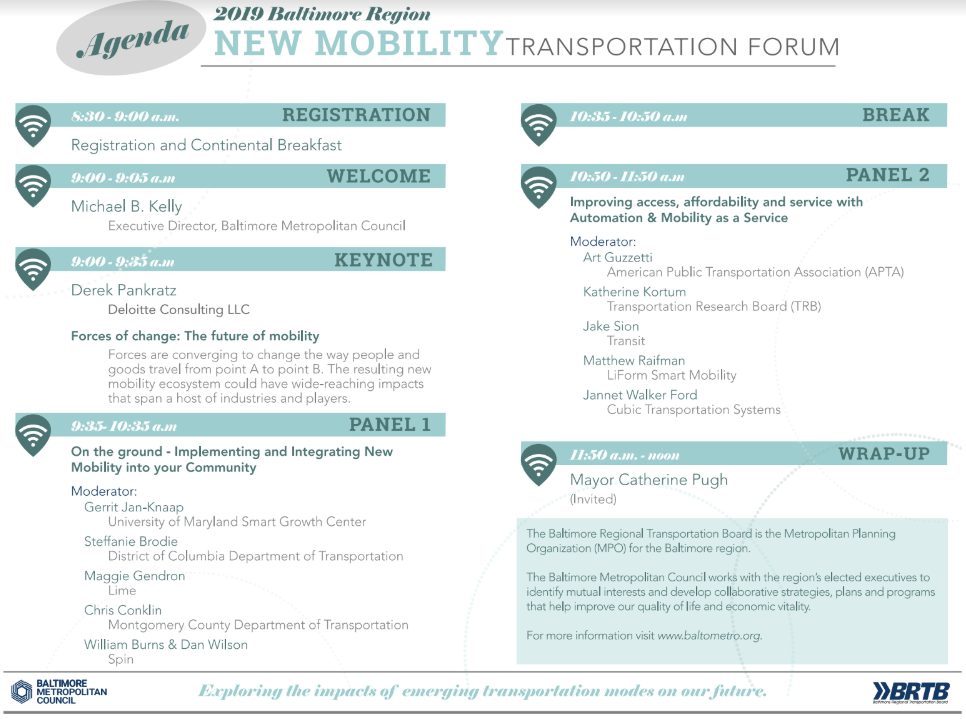
Date And Time
Wednesday, March 13, 2019
9:00 AM – 12:00 PM EDT
Location
University of Baltimore
H. Mebane Turner Learning Commons Town Hall
1415 Maryland Avenue
Baltimore, MD 21201
View Event MaterialsPresentations and video from this event are provided in the box to the right. Thank you for joining us. |
Jake sion - transit Derek pankratz - Deloitte Maggie Gendron - Lime William Burns - Spin Sandra Brecher - Montgomery County New Mobility Forum Video Video Overview |

The Baltimore Regional Transportation Board (BRTB) welcomes comments on its draft Budget & Work Program for Fiscal Years 2020-2021 from Tuesday, February 12, to Thursday, March 14, 2019.
The BRTB is scheduled to vote on the final Budget & Work Program on Tuesday, April 23.
What is the UPWP?
The BRTB’s Budget & Work Program is known as the Unified Planning Work Program (UPWP) for Transportation Planning. It is a federal requirement that details projects, studies and other activities to be completed by BRTB members and staff of the Baltimore Metropolitan Council (BMC.)
The UPWP includes both local and regional activities. The BRTB develops a list of regional transportation planning activities every two fiscal years. This plan includes $7.89 million in funding for FY 2020 and $6.28 million in funding for FY 2021 for planning activities from July 1, 2019 through June 30, 2021.
UPWP funds support staff and several local planning activities. Highlighted new regional projects include:
- Elderly Trip Characteristics and Patterns – The intent of this $100,000 study is to provide policy-makers and planners with an understanding of transportation issues that affect the growing population of those individuals 65 years and older. The purpose of the study is to: identify areas of concentrated elderly populations; conduct an examination of travel behaviors, while identifying patterns and trends; and identify specific policy implications and ways to address current and future needs.
- Regional Traffic Impact Study Guidelines – The intent of a traffic impact study is for a jurisdiction or agency to review how proposed development will affect the surrounding transportation network. This $180,000 project will develop regional traffic impact study guidelines.
- Development Review Practices for Changing Mobility – The popularity of new mobility – such as the ridesharing services of Uber/Lyft, carsharing services of Zip Car, or alternative mode-sharing services of Lime/Bird bicycles or scooters – affects the curb and sidewalk space of public roads and private developments. The intent of this $180,000 study is to: review how jurisdictions in the Baltimore region address new mobility company requests for curb and sidewalk space; identify best practices; analyze the potential shift toward a more flexible use of curb and sidewalk space; and recommend potential improvements to the process.
- Pedestrian Safety and Roundabouts – The intent of this $100,000 study is to increase safety for non-motorists by: analyzing available data to characterize safety concerns for pedestrians in traffic roundabouts; identifying crash trends; and develop recommendations for improving the design of roundabouts.
- Congestion Management Process – The intent of this $200,000 project is to create a step-by-step congestion management process for the Baltimore region, based on the federal guidelines.
Download the Budget & Work Program for FY 2020-2021 or visit BMC to view a printed copy.
View FAQ about the FY 2020-2021 UPWP
B’More Involved
The public is invited to provide feedback on these proposed regional transportation planning activities through Thursday, March 14.
Please send all comments in writing to:
Email: comments@baltometro.org
Twitter: @BaltoMetroCo @BmoreInvolved #BRTBlistens
Mail: The Baltimore Regional Transportation Board
1500 Whetstone Way, Suite 300
Baltimore, MD 21230
Fax: 410-732-8248
The public may also provide feedback during the Public Comment Opportunity at the BRTB monthly meetings on Tuesday, February 26, Tuesday, March 26, or before the vote on Tuesday, April 23. All meeting are scheduled to take place at BMC at 9 a.m.
The BRTB is the federally recognized metropolitan planning organization (MPO) for transportation in the region. BMC provides the BRTB with staff support.
The BRTB operates its programs and services without regard to race, color, or national origin in accordance with Title VI of the Civil Rights Act of 1964, and other applicable laws. Appropriate services can be provided to qualified individuals with disabilities or those in need of language assistance who submit a request at least seven days prior to a meeting. Call 410-732-0500.

Maximize2045 will identify the region's transportation related goals and strategies and list the major projects the region expects to implement over the next 20-25 years.
This spring, the BRTB will release a draft Maximize2045, along with the 2020-2023 Transportation Improvement Program (TIP), for public review. We invite you to get involved in the process to update Maximize2045 by learning more about the steps and staying tuned for upcoming events and the public comment period.
GOALS
The first step in looking at the region’s transportation needs and challenges over the next 25 years is to develop an overarching set of guiding goals and strategies. The BRTB developed the following set of guiding principles for the projects and programs considered in Maximize2045:
- Improve System Safety – Make conditions safer for pedestrians, bicyclists, transit riders and operators, and motorists.
- Improve and Maintain the Existing Infrastructure – Improve the conditions of existing transportation facilities; systematically maintain and replace transportation assets as needed.
- Improve Accessibility – Help people of all ages and abilities to reach specific destinations.
- Conserve and Enhance the Environment – Pass on to future generations the healthiest natural and human environments possible.
- Improve System Security – Provide a secure traveling environment for everyone; improve the region’s ability to respond to natural and man-made disasters.
- Promote Prosperity and Economic Opportunity – Support the revitalization of communities, the development of activity centers, and the movement of goods and services.
- Foster Participation and Cooperation among All Stakeholders – Enable all interested and affected parties to participate and cooperate to find workable solutions.
- Promote Informed Decision Making – Ensure that adopted transportation policies and performance measures guide the regional decision making process.
:: View the detailed list of goals and strategies
FINANCIAL FORECAST
The projects to be included in Maximize2045 must take into account the level of financial resources that can reasonably be expected to be available through 2045.
The BRTB, in consultation with the Maryland Department of Transportation (MDOT), forecasts nearly $12.2 billion in federal, state, and private funds available for major capital projects between 2024 and 2045.
Of the $53 billion in total revenues, approximately $36.7 billion will go towards operations, and $16.3 billion will be set aside for system preservation.
As has been the trend for years, more and more funds are being designated for preservation and operations. As a result, the amount of money forecasted to be available for major capital projects has decreased in each of the past several long-range transportation plans. This makes for some tough choices as the BRTB considers the mix of projects to include in the draft plan.
WHAT'S NEXT?
The next steps of the process to develop Maximize2045 are:
- Project Evaluation – BRTB members have submitted a list of projects they’d like to have included in Maximize2045. BMC staff have evaluated the projects based on the scoring methodology adopted by the BRTB. Using the scoring result, the BRTB will select a list of projects that the region could implement over the next 20-25 years given the amount of money available.
- Draft Plan Released for Public Comments – A draft of the plan will be made public for a comment period during May and June 2019 and we’ll hold a public meeting in each jurisdiction in the Baltimore region.
- Respond to comments and vote on a final plan – The BRTB will then review and respond to public comments and vote on a final plan in July 2019.

BALTIMORE, MD (January 26, 2018) – The Baltimore Metropolitan Council (BMC) hosted a meeting of its Board of Directors on Friday, January 26, 2018 at 8:30 a.m. at the House Office Build in Annapolis. The BMC Board of Directors unanimously approved Anne Arundel County Executive Steven Schuh as its chair and Baltimore Mayor Catherine Pugh as its vice-chair for calendar year 2018.
“Our residents' lives do not stop at our county or city lines. We must remember that we are all in this together, as our strengths - and weaknesses - can be felt across the region," Schuh said. "As the incoming chair of the BMC Board of Directors, I look forward to working with my elected and appointed colleagues from each of our member jurisdictions to enhance our region's quality of life and economic vitality."
Michael Kelly, BMC executive director, said that he looks forward to working closely with Schuh throughout the year.
“County Executive Schuh is a leader whose years of experience representing Anne Arundel County will be an invaluable resource to our organization,” Kelly said. "We look forward to working with him to advance the common priorities of the Baltimore region."
###

BALTIMORE, MD (February 12, 2018) – The Baltimore Regional Transportation Board (BRTB) welcomes comments through Wednesday, March 14, on new projects and funding updates to the 2018-2021 Transportation Improvement Program (TIP) and/or Maximize2040: A Performance-Based Transportation Plan for five Maryland State Highway Administration (SHA) projects and one Maryland Transportation Authority (MDTA) project.
The BRTB is scheduled to vote on the amendments on Tuesday, March 27, at 9 a.m. The BRTB also will host public meetings on Monday, February 26; Tuesday, February 27; and Monday, March 1.
About Maximize2040 and the TIP
Maximize2040 is this region’s $12.5 billion long-range transportation plan developed by the BRTB. Maximize2040 serves as the blueprint for fiscally constrained transportation planning in the Baltimore region from the year 2020 to 2040. The plan also establishes the region’s broad transportation goals and performance measures, which now serve as guiding principles as the region plans and carries out projects.
The 2018-2021 TIP is the list of regional transportation projects requesting federal funding in the near term. It includes more than $3 billion in proposed federal, state and local money for highway, transit, bicycle and pedestrian projects during the next four years. The funding goes towards maintaining, operating and expanding the transportation system. The TIP is fiscally constrained.
Updates occur in Maximize2040 and the 2018-2021 TIP because of changes to project scope and funding or changes to federal documentation policies. Public comment periods and meetings aim to keep communication open regarding these changes.
###
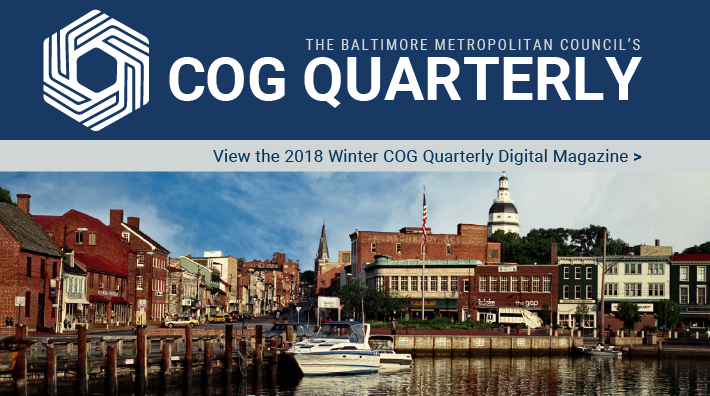
Dear Friends,
When you look at the national news, it’s easy to dismiss Baltimore as a city with great challenges and struggles. But outsiders are discovering what so many of us have known about this region for years: Baltimore is a dynamic destination and it’s only getting better.
Forbes started the momentum when it dubbed us No. 14 on “America’s Coolest Cities to Live” in 2012. Then Zagat crowned Baltimore City No. 2 on “The Top 17 Food Cities of 2015.” So it’s no surprise (but still quite exciting) that we made the New York Time’s “52 Places to go in 2018,” a list of global destinations.
Our Winter 2018 COG Quarterly cover story, “Baltimore Bound,” highlights regional tourism and its intersection with transportation (Page 14). The Baltimore region has something for everyone – whether you’re a foodie or beer connoisseur, a sports fanatic or patron of the arts, nature enthusiast or leisure lover. The tourism industry is a key component of our economy, and it’s an emerging factor in how we approach transportation planning for the future.
Once again, thank you for your interest in BMC and our work.
Sincerely,
Michael B. Kelly
BMC Executive Director
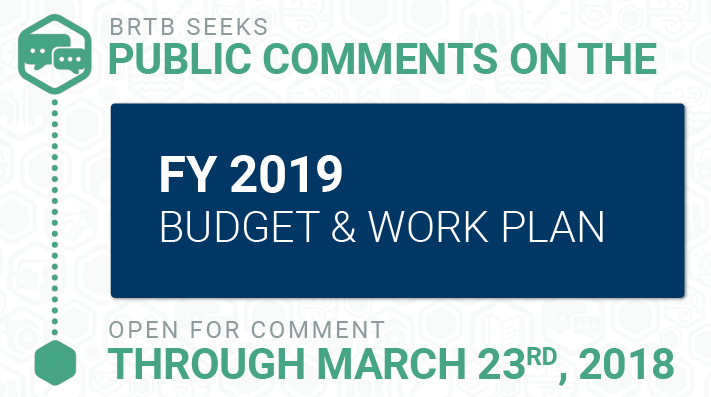
BALTIMORE, MD (February 21, 2018) – The Baltimore Regional Transportation Board (BRTB) seeks public comments on its proposed updated Budget & Work Program for Fiscal Year 2019 through Friday, March 23, 2018.
The BRTB is scheduled to vote on the proposed changes on Tuesday, April 24, 2018.
The BRTB’s Budget and Work Program is known as the Unified Planning Work Program (UPWP) for Transportation Planning. It details projects, studies and other activities to be completed by BRTB members and staff of the Baltimore Metropolitan Council (BMC).
The UPWP includes both local and region-wide activities. The BRTB develops this list of regional transportation planning activities every two fiscal years. This addendum updates the funding tables for FY 2019 and identifies several new tasks.
The updated UPWP includes a total budget for FY 2019 of $7,517,700 that is funded through new allocations of federal transportation funding and projected carryover from FY 2018 to support the additional tasks as outlined below. New local and regional projects include:
- Parole Town Center Transportation Master Plan – Anne Arundel County will conduct a comprehensive assessment of the existing and future mobility needs in the Town Center area.
- Columbia Gateway Transportation Improvement Implementation Strategy – Howard County will conduct a study for the Columbia Gateway, the 8 million squared-feet complex of commercial and industrial space. The complex is an important and critical driver of economic activity in Howard and Anne Arundel counties, as well as the region. It is starting to experience additional development pressure as restrictive covenants on properties expire.
- Kent Island Cox Creek Connector Study – Residents and visitors of Kent Island continue to experience increased traffic on the island, particularly during the summer months when beach-bound vehicles increase along the US 50/301 Bay Bridge Corridor. The majority of the congestion experienced on the island is attributed to increasing traffic volumes on the Bay Bridge, although Kent Island has experienced some growth caused by new residential areas, and retail and business-development. This project is to take the concepts from the Kent Island Transportation Plan and refine them into preferred alternatives and initial design.
The BRTB also proposes adding several new focus areas for BMC staff to pursue. They include:
- Assisting local jurisdictions in preparing project information for the Chapter 30 scoring and Priority Letter submittals;
- Studying and developing guidance on how to accommodate and utilize new or emerging transportation trends and technologies. Examples include: ride-hailing, shared-mobility, electric vehicles, connected and autonomous vehicles, or combination of them to support regional and local transportation, growth, and environmental goals;
- Performing forecasted population and employment scenario analysis. Current forecasts predict shifts in labor exchange between the Baltimore and Washington regions and greater reliance on labor force markets outside of the former. This analysis will explore how changing labor market locations impact planned transportation improvements and what shifts in the local labor market could take place.
B’More Involved
The public is invited to share their thoughts on these proposed regional transportation planning activities through Friday, March 23, 2018. Please send all comments in writing to:
Email: comments@baltometro.org
Twitter: @BaltoMetroCo or @BmoreInvolved, using #BRTBlistens
Mail: The Baltimore Regional Transportation Board
1500 Whetstone Way, Suite 300
Baltimore, MD 21230
Fax: 410-732-8248
Comments may also be shared during the Public Comment Opportunity at the BRTB meetings at 9 a.m. on Tuesday, March 27, 2018, or before the vote on Tuesday, April 24, 2018.
The BRTB is the federally recognized metropolitan planning organization for transportation in the region. BMC provides the BRTB with staff support.
The BRTB operates its programs and services without regard to race, color, or national origin in accordance with Title VI of the Civil Rights Act of 1964, and other applicable laws. Appropriate services can be provided to qualified individuals with disabilities or those in need of language assistance who submit a request at least seven days prior to a meeting. Call 410-732-0500.
###
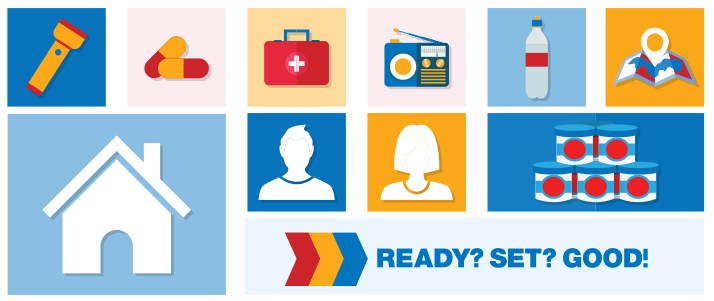
BALTIMORE, MD (April 5, 2018) – Extreme weather, power outages and other disasters happen every day around the world. Residents in the Baltimore region need to prepare at home before an emergency occurs.
“Ready? Set? Good!” is a call-to-action emergency preparedness campaign through the Baltimore Urban Area Security Initiative (UASI) that encourages people to, at minimum, put aside a portable, battery-powered radio, flashlight and one gallon of water per person, per day to help get them through those first critical hours when basic services are down. The campaign targets homeowners, heads of households, moms, dads, caregivers and families to prepare for an emergency before one happens.
The first 72 hours into an emergency are critical. It can take emergency personnel that long to restore basic services – electricity, heat, water, clearing of streets from snow and debris, etc. By preparing at home with a radio, flashlight and water, residents would:know what outside communication is available about the situation; navigate safely around the home; and stay hydrated.
“Ready? Set? Good!” also encourages residents to use a checklist to prepare other items – blankets, non-perishable foods, family plans, pet supplies, etc. Adults should keep a checklist in their wallets or purses as a reminder, and purchase items whenever they are at a store running other errands. For more information, including tips and a checklist of recommended items, visit www.readysetgood.org.
In addition, “Ready? Set? Good!” advertisements will appear on television, radio and digitally through Memorial Day weekend through partnerships with Entercom Communications and the Sinclair Broadcasting Group.
The “Ready? Set? Good!” emergency preparedness campaign is a regional effort funded by the Baltimore UASI, a preparedness grant from the federal government. UASI member jurisdictions include the City of Baltimore, the City of Annapolis, as well as Anne Arundel, Baltimore, Carroll, Harford and Howard counties. The committee also works closely with the Maryland Emergency Management Agency (MEMA).
###
